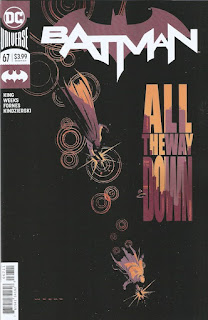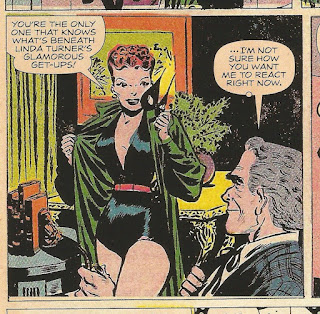Pick of the Brown Bag
March 20, 2019
by
Ray Tate
Welcome, gentle reader. You have found the Pick of the Brown Bag. A weekly review of comic books by yours truly, Ray Tate. For this edition I outline the merits of Athena Voltaire, Batman, Bitter Root, Immortal Hulk, James Bond, Miles Morales Spider-Man and Mystery Science Theater 3000. If you haven’t the time for the full reviews, you can check me out on Twitter: #PickoftheBrownBag.
Bitter Root takes place in the Harlem Renaissance where racism and tolerance exist simultaneously. Some of that tolerance goes the way of the Sangereyes.
An extended family of black occult investigators that the police sometimes consult when faced with strangeness.
The Sangereyes currently contend against a mad scientist.
The crazy dabbler synthesized substances that when catalyzed by emotion turn men and women into monsters. Not happy with just metamorphosis, his experiments somehow opened gateways to nether regions.
The Sangereyes worked from two different fronts to combat this menace. Under the direction of Ma Etta, cousins Cullen, Berg and Blink deal with the so-christened Jinoo in Harlem.
In Mississippi, Ford—the period John Shaft—took down a conclave of Klansmen infected by monsterism then tracked down the source to Harlem.
Bitter Root introduced the black sheep of the family, a sorcerer named Enoch. The bat bunnies accompanying the Sangereyes are his creations and provide visual amusement throughout the story.
Cullen hoped reconciling with his mad uncle would be the turning point, but Enoch seems to be just as a outmatched as the others family members.
The Jinoo somehow infected Berg Sangereye, but he retained his intellect and his vocabulary. Even with his help, the Sangereyes appear to fight a losing battle against perverted science and Eldritch magic.
Newcomers however may turn the tide for Harlem and the world.
Although a plot element in this issue will no doubt make you recall Ant-Man and Wasp as well as the movie Aquaman, Bitter Root still packs enough entertainment, enjoyable familial interaction and originality to make it a must purchase. And if you haven’t added Bitter Root to your subscription list, I’d advise that as well.
Doc Samson returns to The Immortal Hulk. Doc Samson started out as a jackass and continued that trajectory for much of his stay in the Hulk's adventures.
He was supposed to be a psychoanalyst. He became a gamma irradiated Doc Savage with long hair that once determined his power levels. Hence, Samson.
During his run of The Incredible Hulk, John Byrne turned Samson into a wannabe executioner of Hulk. The Hulk devoid of Bruce Banner’s influence became an animal-like monster that had to be put down. The comic book became a visual wrestling match. After this episode, Samson regained his composure and turned up in a run of She-Hulk.
Very few Hulk writers actually utilized Doc Samson as a professional, an actual doctor of medicine and psychiatry. When they did he usually appeared that way in cameo. Essentially, the writers turned to Samson for a more coherent superhero that countered the Hulk's rudimentary speech and blunt behavior.
In the end, Samson actually had his moment of heroism. Both in terms of self-sacrifice and adherence to his ethics.
Alas, he died in the process. As we discover in Immortal Hulk. Those irradiated by gamma cannot die. They may look dead. They may seem very dead, but at night, they will Hulk-out. When their Hulk personae subside, they will return to life. Samson was no different.
Like the Hulk, he doesn't know why, or how. It just happens. Samson checks in with SHIELD and old friends. When he hears of Hulk sightings, he goes to investigate with the pure altruistic intent to help his patient. He finds a sniper sent from General Fortean's group. The sniper thought he killed the Hulk, but...
Don't worry despite Joe Bennett's wonderfully ghoulish designs the Hulk gets better. Samson does his best to avoid a fight and reason with the Hulk. The Jade Giant heals and becomes more articulate.
I actually liked Doc Samson for the first time. I always thought he was a visually appealing character--apart from his ludicrous nineties Hulkutioner gear. More in keeping with the Village People, but here, Samson genuinely seeks to help the Hulk, understand him and what his persona means for Banner.
He's psychiatrist first and superhero second. Samson asks the Hulk if he wants to end the world, and the answer is surprising and profound.
Ewing uses common Hulk dialogue like puny and weak in new contexts that once agains identifies the Immortal Hulk as a thinker. As with previous issues, we get a glimpse of the classic Hulk, and this is interesting as well.
If you were to tell me that I would be so engrossed in a Hulk book, I'd laugh in your face, yet here I am totally invested in Immortal Hulk.
Tom King in his latest Knightmare presents one of his most bizarre concoctions. He starts off with a rooftop confrontation. Batman corners the culprit—a mystery man with an outre mask.
There’s nowhere to go but down, and that’s what the strange foe chooses. His direction predicates a chase expertly sprawled out by Lee Week and Jorge Fornes.
Batman bounces between fire-escapes. He drops down a stairwell all to capture his quarry. Who says nothing and seems hellbent on staying out of Batman’s hands.
Batman launches Batarangs at his foe and falls through the skylight at Porky’s bar. It’s odd how often Porky’s bar and the humanized Porky Pig introduced in the Batman/Looney Tunes crossover reappears in King’s works.
The chase goes on and on until finally, Batman unmasks the villain. The visage comes as a genuine shock. When you read Batman’s only narration. Your left with three words. What. The. Hell.
Miles Morales does Ferris Bueller's Day Off with seventies comic actor Martin Mull performing in the place of Jeffrey Jones.
The other difference lies in Miles Morales actually being the antithesis of Ferris. Ferris is a mostly irresponsible youth who cuts class often. His day in the film is special since its the end of his High School Years. We let him get away with it because Ferris is clever and his break of the fourth wall lets the audience know that its only a movie. Nobody's condoning truancy.
Of course being a superhero book Miles' Day Off is fraught with superhero events. Subways for example seem to be the bane of a superhero holiday.
And what would a superhero fun day be without a loser villain. Introducing Miles' Morales' Hypno-Hustler.
The Frost Pharaoh is a hilarious oxymoron concocted by writer Saladin Ahmed.
This issue is furthermore a great jumping on point for readers. Miles employs most of his powers from camouflage to webbing. Ahmed and user-friendly artist Javier Carron introduces a cast of characters that include Miles' immediate friends, his civilian adversaries and his girlfriend, who gets to be more than his girlfriend. Ahmed gives her a life outside of Miles' sphere--no Betty Ross is she. Carron imbues her with visual attitude.
Miles' fight against time leading to tardiness and absences is in fact due to his being a highly responsible Spider-hero. Ironically, on this day, Vice Principal Dutcher happens to be one-hundred percent on target. Miles is in this instance ducking out from school for a purely pleasurable experience, yet you root for him. He's clever, and he saved a subway full of people from being injured or killed in a subway derailment. So, back off, Lyle.
This issue of the MST3K 3000 fires on all cylinders. The story began with Kinga, daughter of Dr. Clayton Forrester, sequencing the SOL's current captive Jonah and bots Tom Servo and Crow into cheesy comic books. This issue starts with a Prisoner gag.
A bonus occurs when the jokes stress common, even trivial art techniques from the period. When reading these comic books you never questioned the things the wisecrackers notice, like a person suddenly turning green to equivocate camera tricks or mountains becoming pink in the background.
Next, Jonah continues his place-taking of the original Black Cat's wannabe boyfriend. As I stated before, I'm a fan of Harvey Comics' Black Cat.
Make no mistake one part of this is the pure admiration of good-girl art. The other parts are the judo throws. Okay, the percentages may be debatable, and maybe not so pure, but a lot of my fandom really really lies in the action-illustration by Lee Elias.
Black Cat is secretly Linda Turner, a stuntwoman whose skills come in handy when fighting bad guys. Black Cat is a feminist role model. She cycles, ropes, jujitsus and karates her foes. Lee Elias made these moments thrilling and above all athletic.
Of course, Harold Buchholz, Joel Hodgson and company pull one of the Black Cat stories that's just rife with asian stereotypes. Thus, making my appreciation somewhat embarrassing. At least the Asian-Americans aren't demonized as they were in World War II. Yeah, I'll take that.
The creative team also mentions the pre-comics code authority violence which was an added draw. In addition, they don't make fun of the Black Cat herself, but the tropes surrounding her. So, Black Cat fans will enjoy this as well as those who don't know Black Cat from beans.
Last but certainly not least, Crow returns to his role as Crypt Keeper in the crudely illustrated "Iron Doom." A goofy Iron Maiden story that almost doesn't need Crow's help. Nevertheless, this is way better reading with riffs.
There’s this inside joke amongst the crew of the Satellite of Love and their fans. It involves rock climbing. In the terrible film Lost Continent the cast spend fifteen to twenty minutes padding the movie with—you guessed it rock climbing. The rock climbing in Athena Voltaire is considerably more exciting. Nazis aren't known for their patience.
The conclusion to "Golden Dawn" is a riveting alternate take on Raiders of the Lost Ark. First of all you have spectacular artist Yusuf Idris taking directions from writer Steve Bryant to make the most exciting rock-climbing sequence since James Bond's For Your Eyes Only. Then you drop Athena and her friends Des and Pippa Nightengale in the middle of a Nazi occult ritual with familiar trappings but different outcomes.
A firefight interrupts the spook show, but the specters are mere background. The fights against the living are in fact more eye-catching than the battles against the undead.
The climax occurs when Athena must duel the nemesis she made since her return to comics Baron Von Sturm.
Lee, John Lee. Writer Greg Pak totally gives over James Bond's comic book to his new Oddjob. In this case readers won't mind Bond stewing in a cell while Lee takes the spotlight. He's a fascinating creation.
When MI-6 and the South Korean Intelligence Agency join forces. So do Bond and Lee. Begrudgingly. Last issue, we discovered that Bond and Lee weren't necessarily after a dirty bomb but something more valuable. Gold. Still, this would fund ORU's operations. Taking it off the market would still count as a win for the free world. Lee however harbors his own, albeit admirable, agenda.
Agent K is the ORU agent that tried to kill Bond and apparently only pretended to try to kill Lee. ORU subverted K with cutting edge scientific torture. John intends to free her from ORU servitude.
Of course, it's more complex than a simple rescue operation. However, that operation is a sight to behold, full of spy craft and comedy. Pak also has the audacity to introduce a character ala' Buffy the Vampire Slayer just to kill him off, and while the relationships impress as much as John's altruism and loyalty to a friend, keeping with Bond actually, the payoff last page makes one gasp.









































No comments:
Post a Comment